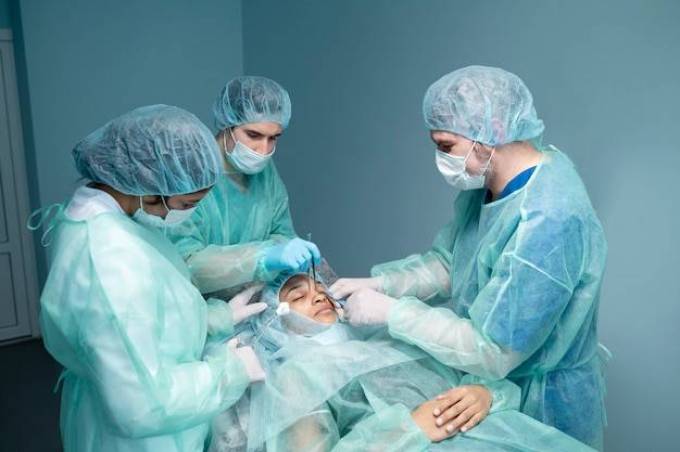Rhinoplasty: A Nose That Fits Your Face
Published By Dynamic Aesthetic Clinic, 27 Aug 2024

Rhinoplasty, commonly known as a nose job, is a surgical procedure aimed at improving the appearance and functionality of the nose. This intricate surgery holds both aesthetic and functional significance, making it a popular choice among individuals seeking facial balance, enhanced self-esteem, or relief from breathing issues.
Understanding Rhinoplasty:
Rhinoplasty in Dubai can be broadly categorized into two main types: aesthetic rhinoplasty and functional rhinoplasty. Aesthetic rhinoplasty focuses on enhancing the nose's appearance to achieve a more harmonious facial profile. Common alterations include modifying the size of the nose, reshaping the tip, or adjusting the nasal bridge. Functional rhinoplasty, on the other hand, is primarily concerned with restoring proper breathing function, often addressing structural abnormalities like a deviated septum.
The Consultation Process:
Before undergoing rhinoplasty, a comprehensive consultation with a qualified surgeon is essential. This initial meeting typically involves:
- Assessment of Facial Proportions: The surgeon evaluates the patient’s facial features to determine how a nose reshaping can enhance overall aesthetics.
- Discussion of Expectations: Open communication about desired outcomes is fundamental. Patients should express their goals, and the surgeon will provide realistic insights based on individual anatomical considerations.
- Comprehensive Examination: A thorough examination, including imaging studies, may be conducted to assess internal structures and ensure that functional improvements can be achieved alongside cosmetic enhancements.
Preoperative Preparations:
Preoperative preparation is critical for successful rhinoplasty. Patients are often advised to:
- Avoid Blood Thinners: Medications such as aspirin and certain supplements should be halted to reduce the risk of excessive bleeding during surgery.
- Plan for Recovery: Understanding the recovery timeline is important for setting realistic expectations. This includes arranging for necessary assistance during the initial days post-surgery.
The Surgical Procedure:
Rhinoplasty can be performed using two primary techniques: open and closed rhinoplasty.
Open Rhinoplasty: Involves making incisions across the columella, the strip of tissue between the nostrils. This approach allows for greater visibility and easier manipulation of nasal structures, which is particularly beneficial for extensive reshaping.
Closed Rhinoplasty: All incisions are made within the nostrils, resulting in no visible scarring. This technique is preferred for less complex cases where minimal alteration is required.
The surgery typically lasts between one to three hours, depending on its complexity. Anesthesia can either be general or local with sedation, depending on the patient’s needs and the surgeon's recommendations.
The Recovery Process:
Recovery from rhinoplasty is a crucial phase that requires patience and adherence to medical advice. Patients can expect:
- Swelling and Bruising: These are common post-surgical symptoms, often peaking within the first few days. Cold compresses and elevation can help mitigate discomfort and reduce swelling.
- Nasal Packing and Splints: In some cases, nasal packing may be used to support the new structure and control bleeding, along with external splints that help maintain the desired shape.
- Limitations on Activities: Strenuous exercise and heavy lifting should be avoided for several weeks. This precaution is vital to ensure proper healing and to prevent complications.
Most patients can return to work or school within a week, but complete healing and the final aesthetic results can take up to a year to fully materialize.
The Aesthetic Outcome:
The outcome of rhinoplasty largely depends on the skill of the surgeon and the patient’s individual anatomy. A well-executed procedure enhances facial harmony while maintaining the nose’s unique characteristics. Patients should expect gradual changes, watching as swelling subsides and the final shape emerges, often yielding a significant boost in confidence.
Emotional and Psychological Considerations:
It is essential to recognize the psychological aspects associated with rhinoplasty. For many, the surgery serves not only as a means of improving their physical appearance but also as a catalyst for increased self-esteem and social confidence. However, maintaining realistic expectations is paramount to ensure emotional well-being post-surgery.
Choosing the Right Surgeon:
Selecting a qualified and experienced surgeon is perhaps the most critical factor in ensuring a successful rhinoplasty outcome. Patients should thoroughly research potential candidates, reviewing their qualifications, previous work, and patient testimonials. A trustworthy surgeon should prioritize patient education, conveying the risks and benefits associated with rhinoplasty candidly.
Conclusion!
Rhinoplasty is more than a mere cosmetic procedure; it is a transformative undertaking that can harmonize facial features and improve functionality. By working closely with a skilled surgeon, patients can achieve a nose that not only fits their face aesthetically but also enhances their quality of life. As with any surgical intervention, informed decision-making and careful consideration of the psychological implications are key to a satisfactory outcome. Ultimately, rhinoplasty offers individuals the opportunity to embrace their unique beauty, fostering confidence and satisfaction with their appearance for years to come.
